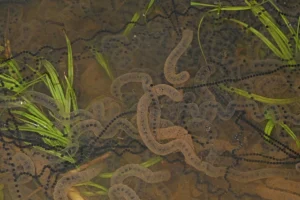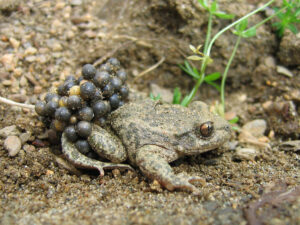Most toads reproduce by laying eggs, usually in clam, shallow, bodies of fresh water. However, some toad species can lay their eggs in brackish water, and others, in relatively fast-flowing streams.
Depending on the species, toads can lay anywhere from 10, to as many as 40,000 eggs at a time. The eggs are usually laid in long strings, along plants, or resting on the pond bottom. Some species such as the eastern narrow-mouthed toad, lay their eggs in a surface film on the water’s surface.
Others, such as the red-spotted toad lay their eggs singly. The small eggs may adhere to each other and form small clusters on the pond’s bottom.
In a few toad species, such as the midwife toads, the males carry the fertilized eggs with them on land, to protect them from predators present in the water.
How Many Eggs 40 Species of Toads Lay
There are over 300 toad species around the world. They live in a very wide range of habitats, from humid forests to mountainous areas, to dry regions.
Different toad species have developed breeding strategies that are practical for the environments they live in.
For this reason, the number of eggs a toad lays can vary, sometimes very widely, between different species.
Some toads, like the Oriental fire-bellied toad, may only lay a few dozen eggs at a time, while large cane toads can lay over 35,000 eggs!
Below is a table that shows approximately how many eggs 40 toad species lay at a time.
Toad Species |
Scientific Name |
How Many Eggs They Lay (Approx.) |
| American toad | Anaxyrus americanus | 2,000 – 20,000 |
| Fowler’s toad | Anaxyrus fowleri | 2,000 – 6,300 |
| Western toad | Anaxyrus boreas | 3,000 -16,500 |
| Cane toad | Rhinella marina | 8,000 – 35,000 |
| Great Plains toad | Anaxyrus cognatus | 1,300 – 20, 000 |
| Canadian toad | Anaxyrus hemiophrys | 3,000 – 20,000 |
| European toad | Bufo bufo | 1,500 – 5,000 |
| Natterjack toad | Epidalea calamita | 3,000 – 7,500 |
| Arizona toad | Anaxyrus microscaphus | 4,000 – 5,000 |
| Southern toad | Anaxyrus terrestris | 2,500 – 4,000 |
| Colorado River toad | Incilius alvarius | 7,500 – 8,000 |
| African common toad | Sclerophrys regularis | 1,500 – 6,000 |
| Mexican burrowing toad | Rhinophrynus dorsalis | 2,000 – 8,000 |
| Oriental fire-bellied toad | Bombina orientalis | 80 – 300 |
| European fire-bellied toad | Bombina bombina | 15 – 40 |
| Wyoming toad | Anaxyrus baxteri | 6,000 -14,000 |
| Eastern spadefoot toad | Scaphiopus holbrookii | 1,000 – 2,500 |
| Western spadefoot toad | Spea hammondii | 300 – 500 |
| North American green toad | Anaxyrus debilis | 1000 – 1,500 |
| Red-spotted toad | Anaxyrus punctatus | 1,500 – 5,000 |
| Houston toad | Anaxyrus houstonensis | 500 – 6,000 |
| Eastern narrow-mouthed toad | Gastrophryne carolinensis | 500 – 850 |
| Western narrow-mouthed toad | Gastrophryne olivacea | 600 – 2,000 |
| Yosemite toad | Anaxyrus canorus | 1,000 – 2,000 |
| Woodhouse’s toad | Anaxyrus woodhousii | 12,000 – 28,000 |
| Oak toad | Anaxyrus quercicus | 300 – 500 |
| Arroyo toad | Anaxyrus californicus | 4,000 – 5,000 |
| Sonoran green toad | Anaxyrus retiformis | 50 – 200 |
| Great Plains narrow-mouthed toad | Gastrophryne olivacea | 650 – 2,100 |
| Coastal plains toad | Incilius nebulifer | 2,000 – 20,000 |
| Great Basin Spadefoot | Spea intermontana | 300 – 1,000 |
| New Mexico spadefoot toad | Spea multiplicata | 600 – 1,070 |
| Amargosa toad | Anaxyrus nelsoni | 3,000 – 6,000 |
| European green toad | Bufotes viridis | 9,000 -15,000 |
| Common midwife toad | Alytes obstetricans | 20 – 62 |
| Asian common toad | Duttaphrynus melanostictus | 6,000 – 40,000 |
| Miyako toad | Bufo gargarizans miyakonis | 12,000 -14,000 |
| European common spadefoot toad | Pelobates fuscus | 480 – 3,000 |
| Iberian spadefoot toad | Pelobates cultripes | 1,000 – 7,000 |
| Syrian spadefoot toad | Pelobates syriacus | 5,500 – 6,500 |
Why Do Most Toads Lay So Many Eggs?
Toads (and frogs) lay large numbers of eggs as a natural way to counter the extremely high mortality rates they experience in their early life stages.
Most toads leave their eggs shortly after laying them. This means the eggs (and tadpoles) are vulnerable to predators, and environmental conditions – leading to very low survival rates.
Toad eggs are often preyed on by water beetles, and many other predators present in the water.
Also, sometimes the ponds where the eggs are laid dry up, which kills the developing embryos or the tadpoles soon after they hatch.
Very Few Tadpoles Survive Long Enough to Become Toads
Of the tadpoles that hatch, there will be intense competition for food and limited resources, meaning again the number of tadpoles will naturally thin out.
Many species of tadpoles are even known to eat smaller, vulnerable tadpoles – further reducing the numbers.
When the toadlets leave the water, only a few will live to adulthood and reproduce. The rest will get eaten by predators such as snakes, raccoons, and a wide variety of birds.
Many toads are also run over by cars, or killed by humans in other ways before they ever get to reproduce.
How Do Toads Lay Their Eggs?
Most toads lay their eggs in long strings (one to three eggs wide) along plants or resting on the pond bottom. The eggs are covered in jelly and look almost like jelly-coated necklaces.



Sometimes sediment settles on the egg strands, covering individual eggs and making them look like giant worms.

Some species, such as the eastern and the western narrow-mouthed toads lay their eggs in small packets that form a single-layered film on the surface of the water.
The eggs look like small, floating dots and may be in small groups or a large raft, depending on how much they have been disturbed.

A few toad species, such as the red-spotted toad lay their eggs singly. The small eggs may adhere to each other and form small clusters on the pond’s bottom.
Oak toads lay their eggs singly or in small strands of up to six to eight eggs, either free-floating or attached to vegetation.
Midwife Toads Carry Their Fertilized Eggs With Them on Land, Until They Hatch
Midwife toads are found in most of Europe and northwestern Africa. In these toads, the males carry the fertilized eggs on their backs, to protect them from predators present in the water.

They keep the eggs moist by lying in damp places during the day and going into the water to swim if there is a risk of the eggs drying out.
When the eggs are ready to hatch, the male will detach them into a calm, shallow freshwater body, where the tadpoles can develop undisturbed.
How Often Do Toads Lay Eggs?
Most toad species lay one or two clutches per year in the warm spring or summer months after heavy rain, but some toad species in some regions can breed year-round.
The breeding season for toads (and frogs) is largely stimulated by rainfall, higher temperatures, and the availability of food. Spring or summer rain creates puddles and fills ephemeral ponds, and other water bodies for toads to lay their eggs in.
How frequently a toad will lay eggs largely depends on the climate it lives in.
For example, Eastern spadefoot toads (Scaphiopus holbrookii) only breed from March to August in the Northern part of their range but can breed during any month in the Southern part as the climate is more favorable.
In favorable weather, eastern spadefoot toads can lay eggs up to 3 times per year. They are also known to sometimes go a whole year without breeding.
Cane toads (Rhinella marina) in Australia are known to breed once or twice per year.
Some Toads Do Not Lay Eggs
While most toad species lay eggs, there are some exceptions. For example, Frontier forest toads (Nectophrynoides frontierei), found in the Eastern Arc Mountains of Tanzania,
Instead, they retain the eggs inside their bodies until they hatch, and then give birth to young fully-developed toads. This is known as “Ovoviviparity.”
More About Toad Eggs
Learn more about toad eggs in these interesting guides on our site:
Common Questions About Toad Eggs
Do Toads Die After Laying Eggs? Toads do not die after laying eggs. However, sometimes, toads may drown during mating, or die of exhaustion from the mating activity. This usually happens in very hot, or very cold weather. Also, some toads are killed by predators during, or shortly after mating.
What are Toad Eggs Called? Toad eggs are called “toad spawn”. They are usually laid in long, jelly-covered strings along plants or resting on the pond bottom. Sometimes sediment settles on the egg strings, covering individual eggs and making them look like giant worms.
Photo credit: Henk Monster, CC BY 3.0

